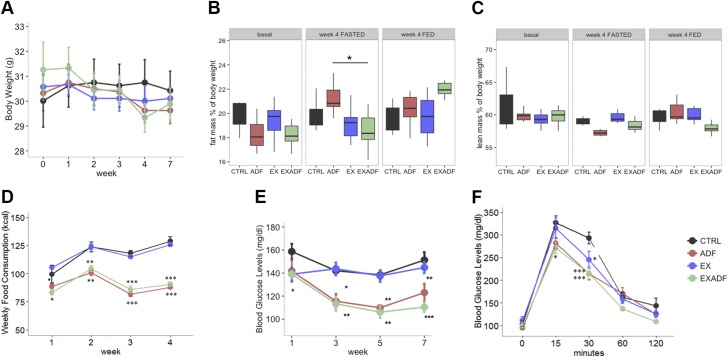Figure 2.
Mice on ADF diet, with or without daily treadmill running, have reduced overall calorie intake, retain body mass, and exhibit improved glucose tolerance compared to mice fed ad libitum. A) Body weight. Body weights of mice in ADF, EX, and EXADF groups were not significantly different than mice in CTRL group at any time point. B) Fat mass as percentage of body weight. ADF mice had significantly more fat mass than EXADF group on food-deprivation day but not feeding day. There were no other significant differences in fat mass between groups. C) Lean mass as percentage of body weight. There were no significant differences in lean mass between groups. D) Food consumption during intervention wk 1–4. ADF and EXADF mice consumed fewer calories than CTRL and EX groups during wk 1, 2, 3, and 4. E) Blood glucose levels. Blood glucose levels were significantly lower in mice in ADF and EXADF groups compared to mice in CTRL and EX groups during wk 1–4. F) Results of glucose tolerance test. Blood glucose levels were measured 15, 30, 60, and 120 min after intraperitoneal injection of glucose (2 g/kg of 30% glucose solution). Two-way ANOVA was conducted on influence of ADF and exercise on glucose tolerance over course of 2 h. Mice in ADF and EXADF groups had significantly lower blood glucose levels compared to mice in CTRL group at 15 and 30 min time points. Group × Time interaction effect was not significant: F(12,125) = 1.59, P = 0.1. Values are means ± sem (n = 8 CTRL, 8 ADF, 9 EX, and 9 EXADF mice). *P < 0.05, **P < 0.01, ***P < 0.001.

